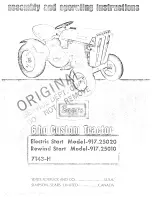
6
PRE‐OPERATIONAL CHECKS
The operator should become familiar with the following
pre-operational check list prior to starting or operating
the HUSKY.
1. Thoroughly clean area around crankcase oil dipstick,
and check for proper level of engine oil. See Engine
Manufacturer's Manual.
2. Check battery for proper electrolyte level.
3. Check gasoline tank for sufficient gas supply.
4. Check that air cleaner if free of debris. Check and clean
regularly. Replace if necessary.
5. Clean flywheel screen. Use a brush or similar to a wire
brush or an automotive snow brush. Check and clean
regularly. Clean engine fins at same time. Clean screen from
R.H. side of tractor. Clean as far as you can reach, turn
engine over until part of screen which is not cleaned is
exposed and finish cleaning. See Figure 14. Remove spark
plug wire to avoid accidental starts.
6. Visually check for loose nuts, screws, and damaged
parts. Replace and tighten before starting engine.
7. Check for even tire inflation. TIRE INFLATION
SHOULD NOT BE LESS THAN 8 LBS NOR MORE
THAN 12.
8. Thoroughly clean area around hydrostatic transmission
fill plug area, and check for proper level of transmission
fluid. Check that transmission lever is in PARK. Start
engine and allow it to idle while checking transmission fluid
level.
9. Do not allow ignition switch to remain in the ON
position when engine is not running. Remove key.
10. Check fuel petcock to be sure it is fully open.
BREAK‐IN PERIOD
As with a new car your new HUSKY tractor should
receive special attention. During the first few hours of
operation, it is best to vary the engine speed (see inside
front cover of engine manual) ... avoid full-throttle
driving ... and avoid quick starts and stops until you have
become well acquainted with your tractor. IMPORTANT:
THE TRACTOR IS SHIPPED FROM THE FACTORY
WITH OIL IN THE ENGINE CRANKCASE. CHECK THE
CRANKCASE
AND
THE
HYDROSTATIC
TRANSMISSION OIL RESERVOIR FOR PROPER OIL
LEVEL BEFORE ATTEMPTING TO START YOUR
UNIT. BECOME FAMILIAR WITH THE LOCATION OF
EACH CONTROL. THIS TRACTOR IS EQUIPPED WITH
INTERLOCK SWITCHES. THE ENGINE WILL START
ONLY WHEN P.T.O. CONTROL LEVER IS IN “OFF”
POSITION AND TRANSMISSION LEVER IS IN “PARK”
OR “NEUTRAL” POSITION.
Both the tractor and engine have been fully tested by the
factory and your dealer to assure your complete
satisfaction. Keep this manual available at all times, read it
carefully; if you have any questions that are not answered
in the manual, consult your Bolens dealer.
STARTING THE ENGINE
ELECTRIC STARTING
1. THE ENGINE WILL START ONLY WHEN P.T.O.
CONTROL LEVER IS IN “OFF” POSITION AND
TRANSMISSION LEVER IS IN “PARK” OR
“NEUTRAL” POSITION.
2. Pull out choke. Experience will indicate need for more
or less choking due to temperature variations, grade of fuel,
engine heat, etc.
3. Pull out throttle one half-way. More or less throttle may
be required due to grade of fuel and temperature variations.
4. Turn ignition key to the right to start engine. Release
key when engine starts.
5. Allow engine to warm up. Move choke slowly forward;
pull out throttle and lock at full speed while operating.
6. To stop the engine, bring engine back to idle, place
transmission lever in “PARK” and “P.T.O. lever in “OFF”
position and turn ignition switch off. Remove the ignition
key when the tractor is not in use, or left unattended. If
engine has been working hard let it idle several minutes
before shutting it off to allow engine ot cool down more
evenly.
EMERGENCY STARTING
In case of electrical failure, proceed as follows: (See first
paragraph under electric starting.)
1. Recharge or replace battery.
2. 12 Volt Jumper cables may be used. NOTE: If
jumper cables are used, cables must be connected,
Positive (+) to Positive (+) and Negative (-) to Negative
(-).
3. After engine has started, allow it to warm up. Move
choke knob slowly forward, pull out throttle and lock at
full speed.
4. Remove tractor battery and have it fully charged as
soon as possible.
5. After the battery is fully recharged and has been
checked, reinstall it in the tractor, being careful to
connect ground cable last.
6. Check generator belt for proper tension. Belt should
depress 1/4 inch between pulleys with normal thumb
pressure as shown in Figure 5. Should adjustment be
required, shut engine off, loosen the 2 lower generator
mounting screws “B” and generator adjusting screw “A”.
Pivot generator outward from engine until proper tension
is obtained.
























